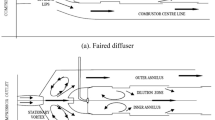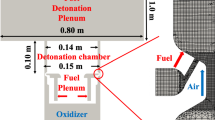Abstract
In this paper, a novel air bleeding aerodynamic diffuser is proposed based on the study of the traditional dump diffuser. The performance and flow characteristics of these two diffusers are compared and analyzed using the numerical simulation method, which is validated by experiments. The effects of length and hole diameter on the diffuser’s performance are also studied. The results reveal that, at inlet Mach numbers of 0.15, 0.20 and 0.30, compared with the dump diffuser, the total pressure loss coefficient of the new diffuser decreases by 18.52 %, 15.05 % and 40.23 %. The performance of the air bleeding aerodynamic diffuser with varing lengths has little change, which means its aerodynamic capabilities are still capable of meeting the requirements of advanced combustion chambers. As the diameter of the air bleed hole increases, the total pressure loss coefficient of the diffuser decreases and becomes gentler.
Similar content being viewed by others
References
A. Klein, Characteristics of combustor diffusers, Progress in Aerospace Sciences, 31 (3) (1995) 171–271.
C. R. Fishenden and S. J. Stevens, Performance of annular combustor-dump diffusers, Journal of Aircraft, 14 (1) (1977) 60–67.
R. Wu, Y. Li, Y. Qiu, S. Li, Z. Liu, F. Bao and R. Zhu, Influence of dump gap ratio on internal flow dynamics characteristics of single channel diffuser, Journal of Propulsion Technology, 41 (3) (2020) 574–581.
S. Aravind, G. Sabarinathan and S. Dhinakaran, Design optimization of dump diffusers with naca 66-021 shaped flame tube, Proceedings of the AIAA Propulsion and Energy 2020 Forum, Online (2020).
Y. Yan, J. Suo and Y. Wu, Parameter optimization of combustor dump diffuser based on RSM, Proceedings of the ASME Turbo Expo 2022: Turbomachinery Technical Conference and Exposition, Rotterdam, Netherlands (2022).
A. Kumar Sahu and P. Ghose, Inlet swirl and dump gap effect on static pressure recovery in dump diffuser-combustor using two equation turbulence model, International Journal of Innovative Technology and Exploring Engineering, 9 (15) (2020) 1214–1223.
J. Tang, X. He and K. Zhang, Influence of dump gap and flow splits on the performance of dump diffusers, Machinery and Electronics, 37 (4) (2019) 34–39.
P. Sathyan, S. Srikanth and I. Dheepan, Studies on aerodynamic characteristics of dump diffusers for modern aircraft engines, Applied Mechanics and Materials, 232 (2012) 246–251.
S. Shen, P. He and M. Shang, The effects of cowling geometry, area ratio and dump gap on a combustor diffusion system, Proceedings of the ASME Turbo Expo 2014: Turbine Technical Conference and Exposition, Düsseldorf, Germany (2014).
A. Duncan Walker, J. F. Carrotte and J. J. McGuirk, The influence of dump gap on external combustor aerodynamics at high fuel injector flow rates, Journal of Engineering for Gas Turbines and Power, 131 (3) (2009) 031506–1–031506–10.
P. He, J. Suo and K. Xie, The influence of dump gap on aerodynamic performance of a low-emission combustor dump diffuser, Proceedings of the ASME Turbo Expo 2013: Turbine Technical Conference and Exposition, San Antonio, USA (2013).
R. C. Adkins, A short diffuser with low pressure loss, Journal of Fluids Engineering, 9 (3) (1975) 297–302.
J. M. Smith and A. J. Juhasz, Performance of a Short Annular Dump Diffuser Using Suction-Stabilized Vortices at Inlet Mach Numbers to 0.41, NASA Technical Paper 1194, NASA, USA (1978).
R. C. Adkins, D. S. Matharu and J. O. Yost, The hybrid diffuser, Proceedings of the ASME 1980 International Gas Turbine Conference and Products Show, New Orleans, USA (1980).
A. Duncan Walker, P. A. Denman and J. J. McGuirk, Experimental and computational study of hybrid diffusers for gas turbine combustors, Journal of Engineering for Gas Turbines and Power, 126 (4) (2004) 717–725.
A. Duncan Walker and P. A. Denman, Hybrid diffusers for radially staged combustion systems, Journal of Propulsion and Power, 21 (2) (2005) 264–273.
R. Srinivasan, G. Freeman and J. Grahmann, Parametric evaluation of the aerodynamic performance of an annular combustor-diffuser system, Proceedings of the AIAA/SAE/ASME/ASEE 26th Joint Propulsion Conference, Washington, D.C., USA (1990).
P. Zhu, J. Suo and H. Liang, A Combustion Chamber with Air Bleeding Aerodynamic Diffuser and Flame Tube, CN111396926 B [P/OL], China National Intellectual Property Administration (2021).
L. Yang, Y. Wei and G. Song, Selection and evaluation of turbulence model, Proceedings of the China Academy of Aerospace Electronics Technology Science and Technology Committee 2020 Annual Conference, Beijing, China (2020).
L. Jiang, RANS modelling of turbulence in combustors, Turbulence Modelling Approaches - Current State, Development Prospects, Applications, IntechOpen (2017).
Acknowledgments
This work is supported by Research Program supported by the National Science and Technology Major Project (Grant No. J2019-III-0022-0066) and the the National Science and Technology Major Project (Grant No. 2017-III-0002-0026).
Author information
Authors and Affiliations
Corresponding author
Additional information
Yue Yan is a Ph.D. student of the School of Power and Energy, Northwestern Polytechnical University, Xi’an, China. She received her bachelor degree from Northwestern Polytechnical University. Her research interests include fluid flow, combustor diffuser and flow test methods.
Jianqin Suo is a Professor of the School of Power and Energy, Northwestern Polytechnical University, Xi’an, China. He received his master degree in Engineering Thermophysics from Beihang University. His research interests are in the area of swirling flow, spray, lean direct injection and lean premixed combustion for aero-engine.
Rights and permissions
About this article
Cite this article
Yan, Y., Zhu, Pf., Li, Dh. et al. Performance and flow characteristics of a novel air bleeding aerodynamic combustor diffuser. J Mech Sci Technol 38, 483–494 (2024). https://doi.org/10.1007/s12206-023-1240-9
Received:
Revised:
Accepted:
Published:
Issue Date:
DOI: https://doi.org/10.1007/s12206-023-1240-9




